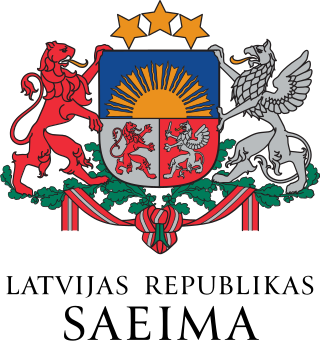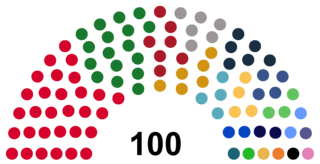 |
|---|
The Party for Peace and Order was a conservative political party in Latvia during the inter-war period.
 |
|---|
The Party for Peace and Order was a conservative political party in Latvia during the inter-war period.
The party was established in 1925, [1] and won two seats in the second Saima in the 1925 elections. It was reduced to a single seat in the 1928 elections, which it retained in the 1931 elections for the fourth Saeima.
The party held similar views to the Landlords' Party in neighbouring Estonia, [1] supporting a classical capitalist economic policy and advocating private property rights. [2] It usually sat in the Saeima alongside the National Union and Christian National Union and some Latgalian parties, in a grouping known as the "National Bloc". [1]

The Latvian Social Democratic Workers' Party is a social-democratic political party in Latvia and the second oldest existing Latvian political party after the Latvian Farmers' Union. It is not currently represented in the parliament of Latvia. The party tends to hold a less Russophilic view than fellow social-democratic party "Harmony".

The Saeima is the parliament of the Republic of Latvia. It is a unicameral parliament consisting of 100 members who are elected by proportional representation, with seats allocated to political parties which gain at least 5% of the popular vote. Elections are scheduled to be held once every four years, normally on the first Saturday of October. The most recent elections were held in October 2022.

The Farmers' Assemblies was a conservative political party in Estonia. Led by Konstantin Päts, it was one of the ruling parties during most of the interwar period.
The Settlers' Party was a political party in Estonia.
The Estonian Socialist Workers' Party was a political party in Estonia.

The Latgalian Christian Peasant and Catholic Party was a Christian centrist political party in Latvia during the inter-war period. It was the largest party in the Latgale region, and was led by the bishop Jāzeps Rancāns.

The Christian National Union was a political party in Latvia in the inter-war period.

The Jewish National Bloc was a political alliance in Latvia in the 1920s. It consisted of Histadruth Hacionith, the Jewish National Democratic Party and Mizrachi.

The Union of Social Democrats – Mensheviks and Rural Workers was a political party in Latvia in the inter-war period led by Marģers Skujenieks.

The National Union was a far-right political party in Latvia during the inter-war period. It was led by Arveds Bergs.

The Latgalian Farmer-Labour Party, also known as the Latgalian Progressive Farmers, was a political party in Latvia during the inter-war period. The party contested elections in an alliance with several other parties under the name United List of Latgalian Small Landless Farmers and Latgalian Labour Party. It was led by Jezups Trasuns.

The New Farmers' Union was a centrist political party in Latvia in the inter-war period.

Agudas Israel was a political party in Latvia in the inter-war period. Primarily a party of the Orthodox Jews, it was the most conservative of the Jewish parties in the country, seeking to limit the power of state monopolies. It was led by Mordehai Dubin.

The Christian Union of Latvian Orthodox, generally known as the Old Believers, was a political party in Latvia in the inter-war period. It was led by M Kalistratov.

The Polish-Catholic Latvian Union of Poles was a political party in Latvia during the inter-war period. It was led by J Wierzbicki.

The New Farmers-Small Landowners Party was a political party in Latvia during the inter-war period. It had two wings; the Farmers wing led by M Gailītis and the Landowners wing led by Ādolfs Bļodnieks.

The Russian Public Workers' Association was a political party in Latvia during the inter-war period. Primarily representing Russian civil servants, it was led by Leontin Spolianski.

The 1st Saeima was the parliament of Latvia from November 7, 1922 until November 2, 1925. It was the first Saeima to be elected after the Constitutional Assembly of Latvia had created the Constitution of Latvia and the Elections Law.

2nd Saeima was the parliament of Latvia from November 3, 1925, until November 5, 1928. The Social Democrat Pauls Kalniņš continued to hold the post of Speaker of the Saeima to which he was first elected during the 1st Saeima.
The Labour League of Latvia was a political party in Latvia. It existed from 1925 until 1934, when all political parties in Latvia were dissolved following a coup d'état. Its political orientation was centre-left, to the left of the Democratic Centre and to the right of the Union of Social Democrats – Mensheviks and Rural Workers.